How to Make Maple Syrup and Maple Syrup Substitute
This is a guest post by Bette Lambert of Silloway Maple.
Maple syrup is a delicious, healthy alternative to refined sugar, and is enjoyed on the table as well as in many recipes. It's simple to make maple syrup in the backyard, though once bitten by the sugaring bug, many go on to expand their operations!
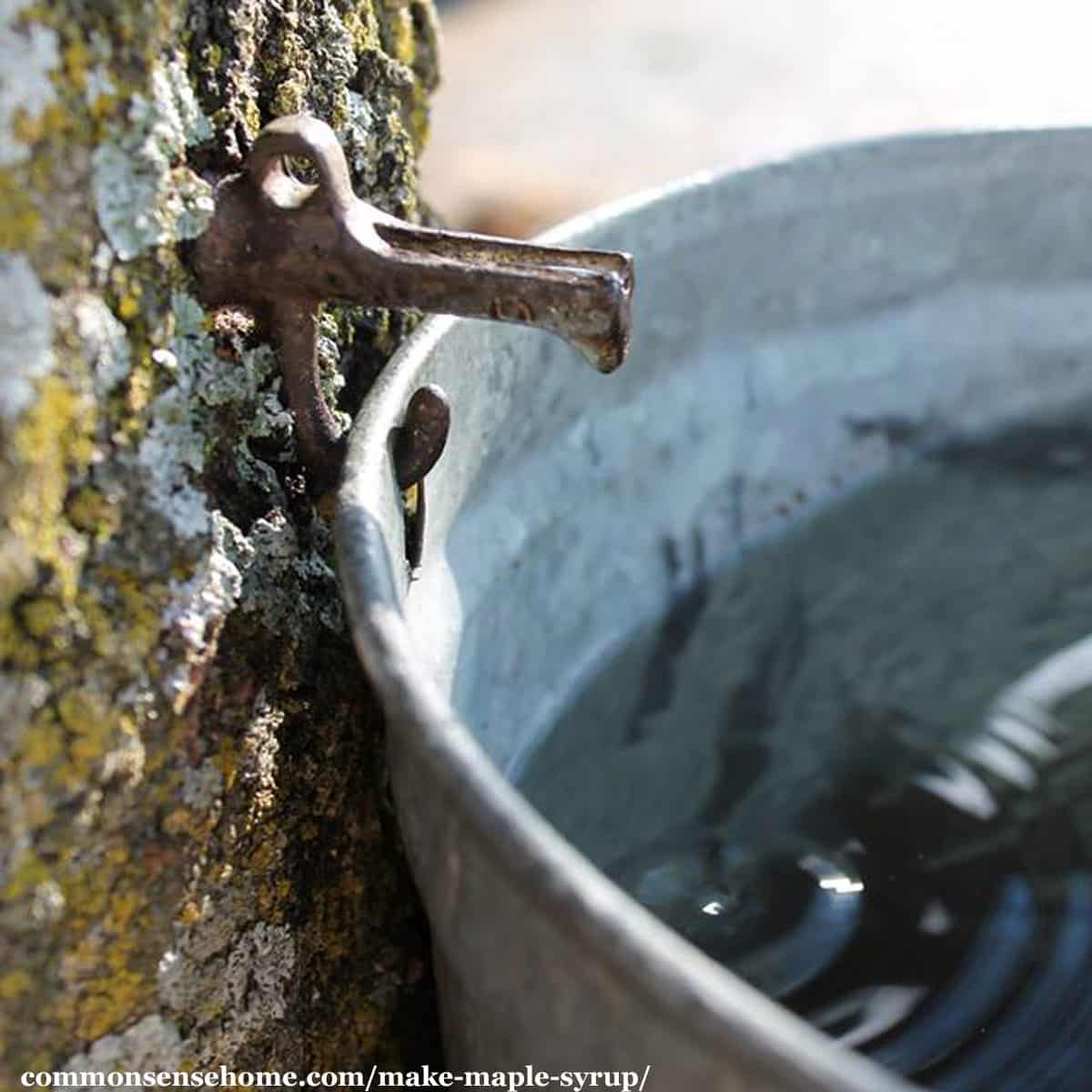
Note: If you're here from the “50 Things You Should Make Instead of Buy” article, we do have a quick and easy homemade maple syrup substitute at the bottom of the page.
7 Steps to Make Maple Syrup
- Identify your maple trees and wait for the right temperature.
- Gather your syrup making equipment.
- Tap the trees.
- Gather the sap.
- Boil the sap.
- Filter and bottle the syrup.
- Enjoy your real maple syrup!
#1: Identify Maple Trees and Wait for the Right Temperature Range
There are many species of maple trees. The sap gathered from all of them can be boiled down into syrup.
Most syrup is produced in the northern states, but can be made as far south as Tennessee.
The temperature must drop below freezing at night and rise above during the day for the sap to run. Trees should have at least a twelve inch diameter before being tapped.
When the maple trees start budding, sugaring is over, as the sap produces bitter syrup.
#2: Gather Your Syrup Making Equipment
Traditional maple syrup making equipment includes sap spouts, buckets, and covers; which are available in hardware stores, from maple sugaring equipment suppliers, or used from other sugarmakers.
To tap the trees you will need a drill and bit, and a hammer. The minimum that a backyard sugarmaker must do is to drill the taphole and tap in the spout.
To collect the sap: Milk jugs or even plastic bags can be hung on the spout; or plastic, food-grade tubing can be connected to the spout and the sap run into a bucket or collecting tank on the ground.
To boil the sap into syrup: Plan how you will boil the sap – a simple pan on the stove, a turkey fryer, an outside set-up over a fire-place, or a larger, purchased arch and evaporator.
Editor's note: a friend of mine cooked her maple syrup down in her kitchen – once. It left a sticky film on every surface. I highly recommend processing outside or in a sugar shack.
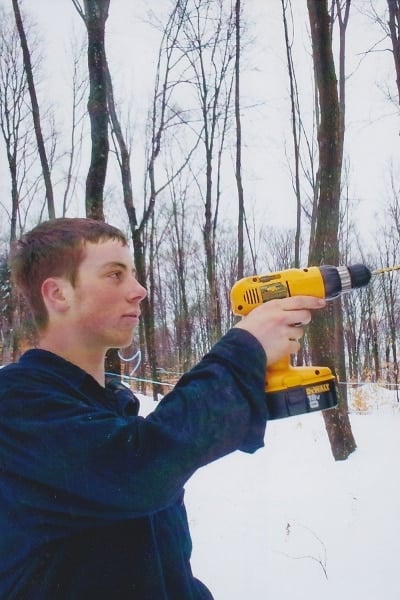
#3 – Tapping Maple Trees
Tap the trees in the early spring, as daytime temperatures rise above freezing. Drill a hole the size of your spout, at a slight incline. (Note angle above.)
Tap the spout into the hole firmly, hang the bucket, and put the cover on to keep out rain and bugs. This is the magic moment, as the first drop of clear, sweet sap runs off the spout – often onto an eagerly waiting tongue!
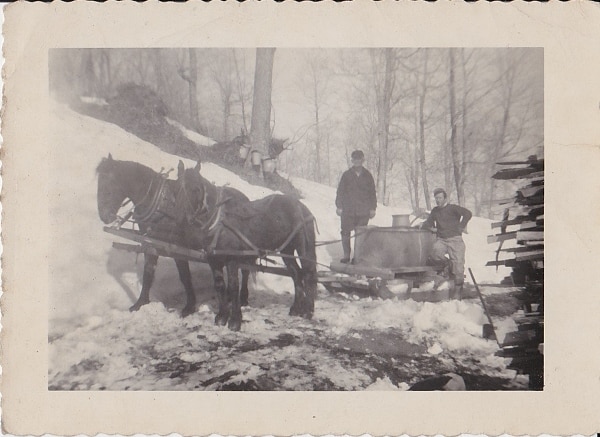
#4 – Gather the Sap
Sap is perishable, and should be gathered and boiled daily, or kept cold in a storage container until boiling. Filter the sap to remove any impurities.
#5 – Boil the Sap
Boil the sap until it reaches seven degrees above the boiling point of water on that day, or until it “aprons”, or runs off a spoon in a sheet. You can also test to see if your maple syrup is ready by using a hydrometer. (See Syrup Hydrometer Instructions to learn how a hydrometer is used for syrup making.)
Whenever maple sap is boiled, it tends to foam up and boil over the side of the pan. Rubbing a little butter around the rim of the pan, or dripping in a few drops of milk or dairy cream during boiling will keep the sap or syrup from boiling over.
My Dad always said, “Never turn your back on boiling sap!” The amount of milk is just a few drops to any size kettle, though dripping in a few more drops is more frequently needed with a larger quantity.
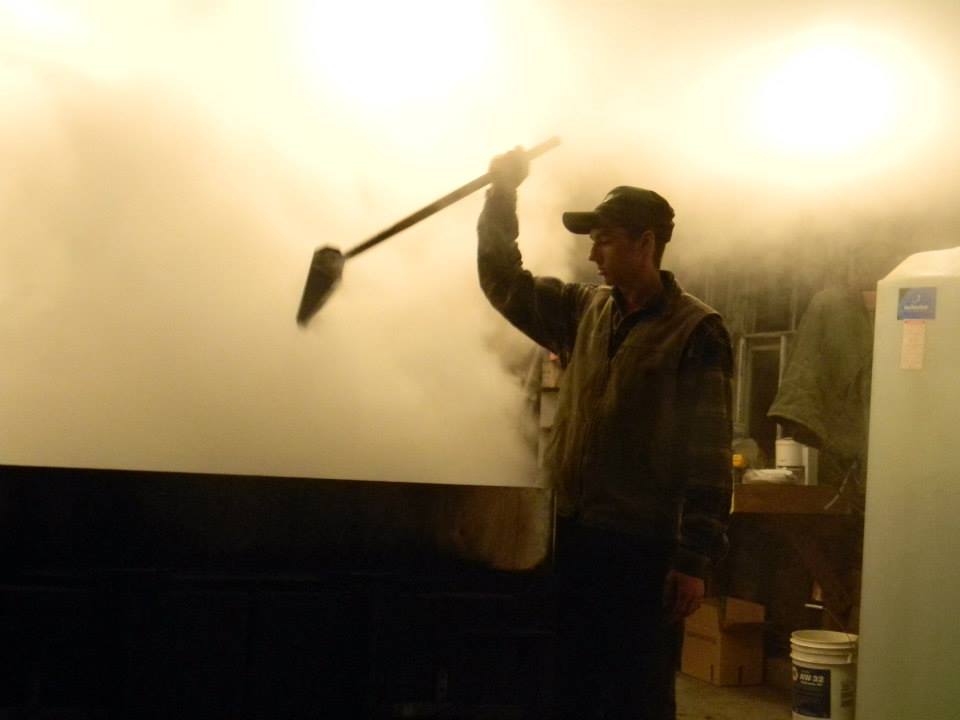
Sugar on Snow
Sugar on snow is made by boiling pure maple syrup to 233 degrees, on a candy thermometer. Do not stir.
We drizzle the hot syrup over pans of packed snow-or directly onto fresh snowbanks! Each person is given a fork to twirl the taffy-like candy up on.
Those in warmer climates may use purchased maple syrup and pour it over crushed ice.

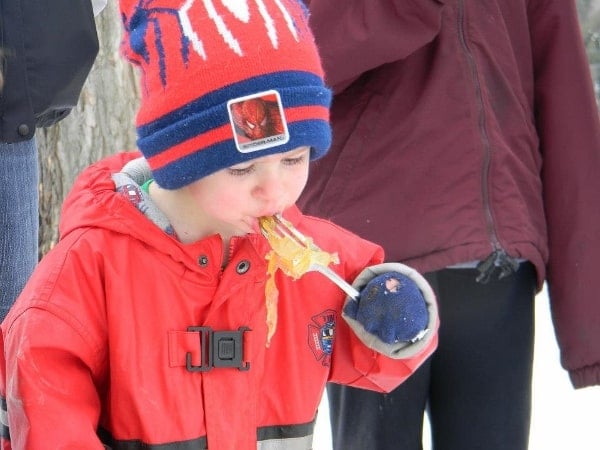
Maple Cream and Candies
We produce maple cream by boiling it to the soft ball stage, cooling it without moving to room temperature, and whipping into a smooth, creamy spread.
Candies, traditionally shaped in molds as maple leaves, are made by boiling the syrup to 243 degrees, and then stirring the syrup while it is hot and pouring into molds before it sets up.
My children used to boil the syrup, and then roll the candy into little balls, pressing in nutmeats. A wonderful treat, made from their big sugar maple in the yard.
#6 – Filter and Bottle the Syrup
Filter the hot syrup through clean wool or synthetic syrup filters to remove niter, or sugar sand. Niter occurs naturally. It is gritty and gives the syrup a cloudy appearance.
Syrup is canned in Mason jars, commercial syrup containers, or kept in either the refrigerator or freezer.
At Silloway Maple, we can our syrup in glass and in plastic jugs by heating it up to 180 degrees. We leave no head space and do not process it in a canner.
The syrup keeps indefinitely, though some say the flavor is best preserved for long periods by freezing. It does not expand, when frozen, like cider.
Once the container has been opened, it should be refrigerated. If any mold does form on your syrup, it is harmless and can be removed by gently heating and skimming off.
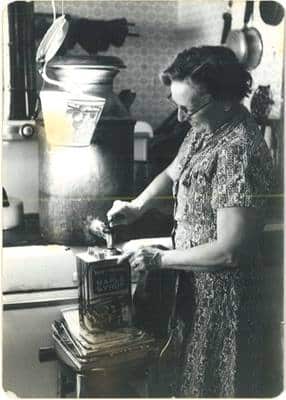
#7 – Enjoying Your Maple Syrup
Maple syrup makes many sweet treats. Enjoy your syrup as pure maple cream, hard sugar, fudge, and maple sugar on snow.
How to substitute maple syrup for sugar (works for most recipes):
- Use ¾-1 cup of maple syrup for each cup of sugar.
- Decrease liquid by 2-4 tablespoons for each cup of syrup used.
- Add ¼ teaspoon of baking soda.
- Decrease oven temperature by 25 degrees.
Maple granola is one of our family favorites, and is very easy to make.
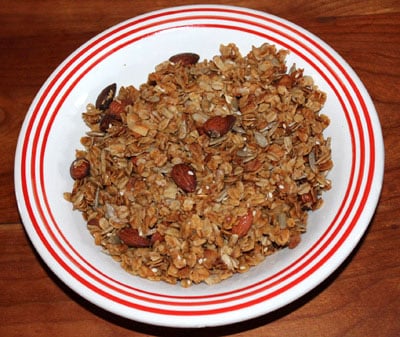
Maple Granola Recipe
Courtesy of Silloway Maple
Ingredients
- 7 c. rolled oats
- 1 c. coconut
- 1 c. almonds
- 1 c. sunflower seeds
- 1 c. oil
- 1 c. maple syrup
- 1 T. vanilla
Directions
Combine the dry ingredients in a large bowl. Mix the oil, syrup and vanilla in a separate bowl, and pour over the oat mixture. Mix well, and spread on baking sheets.
Bake in 300 degree oven for two hours, stirring occasionally. Remove from oven, and add raisins or any additional dried fruit. Store in a tightly closed container.
Is Maple Syrup Healthy?
While maple syrup is a sugar and should be enjoyed in moderation, it does contain naturally occurring minerals such as calcium, manganese, potassium and magnesium.
It's also a natural source of beneficial antioxidants and phenolic compounds. (See “54 beneficial compounds discovered in pure maple syrup” for more information.)
Why are these compounds important?
A quote from the article linked above notes, “We know that the compounds are anti-inflammatory agents and that inflammation has been implicated in several chronic diseases, such as heart disease, diabetes, certain types of cancers and neurodegenerative diseases, such as Alzheimer's.”
The researcher (Seeram) further concludes, “I can guarantee you that few, if any, other natural sweeteners have this anti-oxidant cocktail of beneficial compounds.”
Learn more in the post “Maple Syrup – 6 Things You Need to Know“.
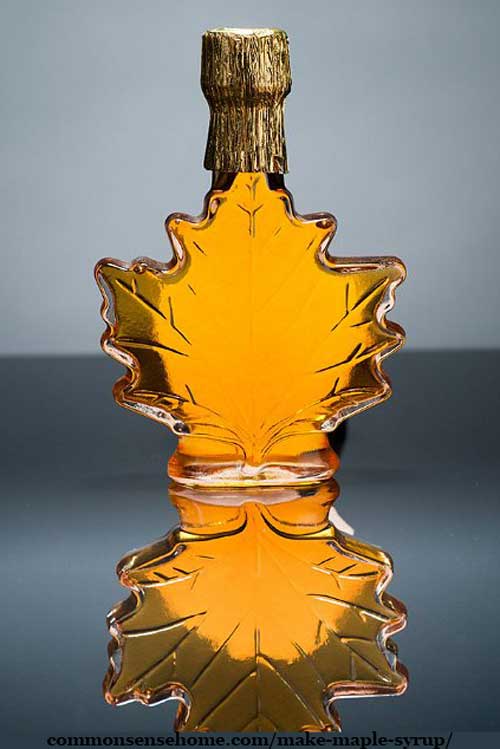
I hope this post will encourage you to make maple syrup, and that it will become a tradition for your family like it is for mine.
Visit Silloway Maple in Vermont
If you don't have access to maple trees, we do sell Pure Vermont Maple Syrup, Maple Cream and Maple Sugar Coated Nuts in our online store, or you can visit a local producer near you to enjoy some real maple syrup.
This is a guest post by Bette Lambert of Silloway Maple in Randolph Center, Vermont. Bette is the mother of six children, all homeschooled. She is a maple sugarmaker and homemaker.
Silloway Maple is family owned and operated. They recently built a new solar-powered sugarhouse, which also produces part of the energy used on the family dairy farm.
Daughter Laura manages the business Facebook page, Silloway Maple, where you can view photos of their sugarhouse, as well as an extensive library of maple syrup making photos.
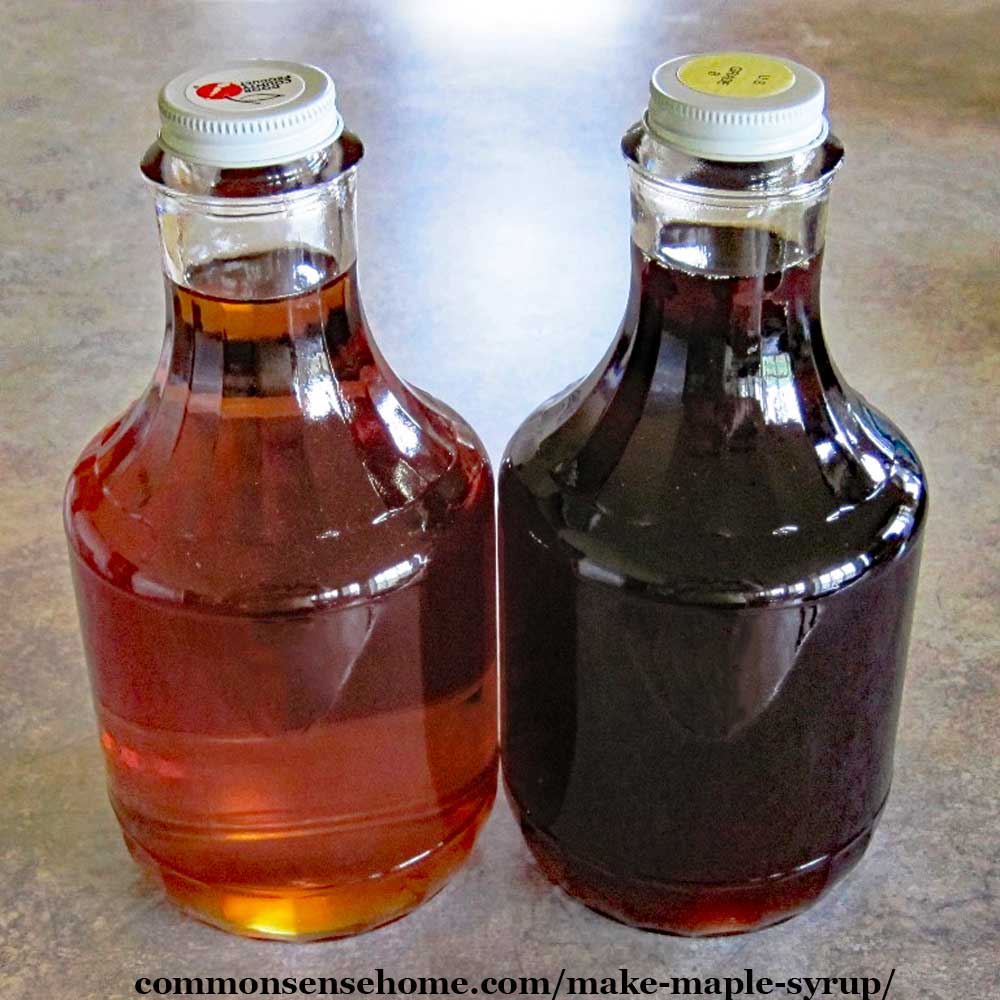
More Maple Goodness
For more information on how to make maple syrup and other maple products:
Some featured recipes:
- Maple Leaf Cookies Made with Real Maple Syrup and Maple Glaze
- Easy Candied Walnuts – For Snacking or Gifts
- Pumpkin Spice Waffles with Maple Cinnamon Whipped Cream
- Maple Macaroons – Refined Sugar Free, Gluten Free, Delicious!
- Indian Pudding
Want to stock up on syrup? Learn how to store it for best shelf life.
For those of you visiting from the “50 Things You Should Stop Buying and Start Making” post who don't happen to have maple trees available and were looking for a quick and easy homemade maple syrup substitute.
Homemade Maple Syrup Substitute
For those who want to make maple syrup substitute at home.
Adapted from All Recipes.com
Ingredients
- 1 cup water
- 1 cup white sugar
- 1 cup brown sugar or sucanat
- 1 tablespoon maple flavored extract (buy pure maple extract here)
Directions
Bring the water and sugars to a boil in a saucepan over medium-high heat. Reduce heat to medium-low, and stir in the maple extract; simmer 3 minutes longer.
Use immediately, or store in a mason jar in the refrigerator for up to two weeks. For a thicker syrup, use two cups brown sugar. You may also substitute 2 cups sucanat (less refined cane sugar) for the sugars. Makes 2 cups of syrup.
I still highly recommend real maple syrup. Real maple syrup has trace minerals and flavor that can't be matched with refined sugars and extract.
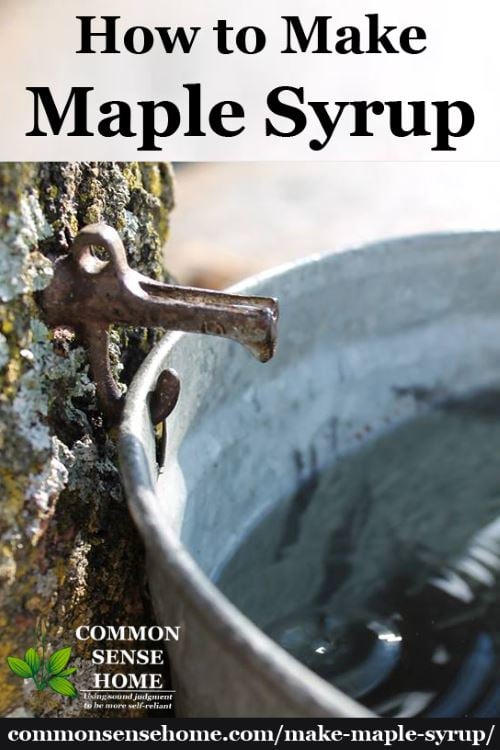
Originally published in 2014, updated in 2015, 2018.






Just tapped my trees at my new home in Washington State. No idea what kind of maple trees they are but I was able to gather 8 gallons of sap thus far, mostly from one tree. Anyway, I brought the first 4 gallons to boil in an old turkey fryer and reduced it down to about a gallon and then brought it inside to finish it off. Pulled if from the heat at 217 degrees and I have to say it was pretty dang good. My second batch was a few days later and it is completely different. The same method was used however this batch is much darker and has a much better maple flavor. I am really having a good time with this. My Wife has Family in PA that own and operate a syrup company and they have been helpful in teaching me the ways. This was a good read!
I haven’t tried a tree syrup yet that I didn’t enjoy. All the subtleties of flavor are amazing (and delicious) to me.
We are tapping, getting ready for another season. We tap 6,200 trees, so it takes a while!
I was thinking that it’s about that time of year again. Today our high is a whooping 10 degrees, so spring is not arriving ahead of schedule here.
Just this morning I had pancakes and real maple syrup made by my family in Canada. I hsve never bought syrup from the store.
What a blessing to have ready access to syrup you can trust.
I have several jars of 3 year old maple syrup it is getting dark if I bring it to a boil would it be still good to put on waffles.
If it hasn’t been opened and there are no signs of spoilage (such as mold or off flavor or smell), it should be fine.
I collect my sap in March 2016 – boiled some down but not fully to syrup. I out it in gallon plastic container and its been in the fridge ever since. I just took it out to finish it by boiling and when I poured it into the pot it was thick like mucilage glue – like thick snot – sorry that’s best to describe it. hat happened is it still good – should I just boil it or throw it out?
I’m 99% sure that some sort of bacteria has moved in and would not recommend cooking and/or eating the snot-like syrup.
I know the season is long gone by…I was talking with my cousin from Coleman Wisconsin who has been making syrup for a lot of years when she told me something I have never heard of before…Using eggs to clear out the sugar sands…she is sending me the directions on how it’s used…have you ever heard of this?
I know the ladies making coffee in the huge coffee pots at church when I was growing up would use eggs to clear the coffee. I’m guessing the process is similar, but I’ve never done it.
We just went for our first maple syrup experience here in Canada. We just came to the right time, freezing at night and above zero during the day. Walking into that sugar shack with all the steam is an image I will never ever forget again. (not to mention the smell)
I tap my (Silver Maples) in Colorado. Sap to Syrup = about 40 to 1. My trees are approx. 15 inches in diameter. I worry about damaging the trees when I tap them, So each year I drill the tap hole at different locations on the tree i.e. North, East, South, West. and height, one year 3 feet above ground, next year 6 feet above the ground. Am I wasting my time?
Minnesota Maple Syrup Producers website states:
“You should drill a new hole at least 6 inches away from the prior tap every year, because the previous year’s tap hole will result in some scarred tissue. Do not “girdle” the tree by tapping in an exact circle at the same height year after year.”
Well, we tried for the first time last year and it turned out very tasty . My only question is my syrup is very thin and runny did I just not boil it down enough?
I’m not sure what consistency you’re looking for or what you obtained, but if you hit the right temp it should be “done”. Real maple syrup does tend to be thinner than standard commercial syrups that are corn syrup based.
We have a few maple trees along our fence line. How many trees does it take to produce enough sap for, say, ½ liter or ½ quart of syrup?
From Cornell University:
It helped me alot you should follow how they make it!
I am 82, grew up in Oklahoma, so didn’t have a maple tree. My mother always made “substitute maple syrup” with water, sugar, maple flavoring, minus the brown sugar. Today, living in Louisiana, still make the syrup for my grand-daughter’s waffles. She knows no other, at my house, loves it.
I boiled my sap down to 219-220 degrees. Then, I filtered it and put it into clean jars, let them all cool, and put them in my freezer. This morning, when I looked, the syrup looks like heavy cream? I took one jar out and let it thaw and it returned to the usual syrup consistency and appearance.
What did I do wrong? Is it edible?
I’m not sure, but it doesn’t sound like you did anything wrong, just that the syrup was frozen.
Why does it turn white when I put it in the freezer?
I’m guessing that what you’re seeing is sugar crystals forming, or ice crystals. Either should disappear with gentle heating.
It’s great to read all the comments from across the country-and Uruguay! We are tapping here now, and looking forward to boiling. There is a lot of snow in the woods! Please stop by if you are traveling through Vermont, and have a look at our website if you live in a climate too warm to make your own “liquid gold”!
Hi Bette! The real stuff is so much better than the substitutes. I don’t remember if I mentioned to you about adding the substitute recipe, but I did it because the post got featured on a site that was sending people here with text saying maple syrup was “so gosh darn easy to make”, so I felt that I had to include something for that crowd. Hopefully most of our readers will understand what’s involved in creating the real thing and will appreciate it.
Thanks for your Homemade Maple Syrup Substitute. You’ve made my day until I saw that little ingredient: “maple syrup extract” !
You have to know two things. First: I’m 57 y.o. and I’ve no job ’cause there’s no job discrimination’s law in my country: Uruguay. Also, my only son is 5 y.o. At Uruguay there’s no possibilities of collecting maple trees’ sap.
So, I have to eat my “homemade” pancakes (I cannot access to “Aunt Jemima” powder) with other than maple syrup and that’s the biggest regret of not being there.
Yours sincerely,
Jorge
You don’t have to use the extract, it just makes it taste more like maple syrup.
Bread machine breads:
Milk can be substituted for water and your fat of choice can be substituted for oil
I use honey or maple syrup instead of sugar
I also use the bread machine to take care of the bread, but put the dough in a pan and bake it at the end. The times are listed below – different temperatures are listed. If I am not baking anything else, I usually use the 400 degree listing.
Our absolute favorite is the oatmeal bread. It only lasts about 3 days without going moldy or being too dry – freeze it if you don’t intend to use it up quick.
The wheat bread is heavy. I don’t add anything to make it rise a bit better.
With any bread machine, always Put into container in order It is listed – Hot water first …..
Options
Can mix milk and 1/3 c water to make 1 1/8 c
2T. Butter melted can replace oil
Can sprinkle ¼ c sugar mixed with 2 tsp.
cinnamon and roll up dough and bake
Can bake in bread pan:
350 for 40 min. or
Metal 400 for 35
Or 425 for 30 min.
1 ½ # loaf
Put into container in order
It is listed.
White bread
1 1/8 C. warm water
1 ½ Tbsp. vegetable oil
1 1/2 Tbsp honey
3 c. white flour
1 ½ tsp. salt
2 tsp. dry yeast
OATMEAL BREAD the best one!
1 1/8 C. warm water
1 ½ Tbsp. vegetable oil
2 Tbsp honey
½ c. ground quick oatmeal
2 ½ c. flour
1 tsp. salt
2 tsp. dry yeast
WHEAT BREAD
1 1/8 C. warm water
1 ½ Tbsp. vegetable oil
1 Tbsp honey
Scant 2 c. white flour
1 c. wheat flour
1 tsp. salt
2 tsp. dry yeast
BRAN BREAD
1 1/8 C. warm water mixed with milk
2 Tbsp. melted butter
2 Tbsp molasses
2 ½ c. white flour
½ c. crushed bran cereal
1 tsp. salt
2 tsp. dry yeast
The kids kit would be great for my grandchildren to get started in maple syrup making!
Thanks for the post! I grew up in Upstate New York and we enjoyed fresh maple syrup every year. One of my teachers had a sugar bush and when I was in grade school we went on a field trip to see how they make maple syrup. It was fun to see the sap in the buckets and to get a taste and then to see how they boiled the sap to make the syrup. Sure would like to try to make my own here in Washington state.
cant wait to try this!
Did you know that in the email you used last year’s date?! I have never that myself (rolling eyes). My street is only 2 blocks long but was built more than 50 years ago. Almost every house has a huge maple tree and my next door neighbour has a fire pit. Now I just need access to a large metal pot.
Nope, completely missed that. It was a really long day. Too late now.
I am ready to tap.
We have a large leaf Maple in our front yard..hoping though we don’t get long stretches of freezing weather, I am able to make this a success!
Found this article to be very helpful and insightful. I’ve always wanted to make my own maple syrup. Thanks for sharing!
We just started experimenting with maple syrup. I now understand why it’s so costly to buy.
Thank you so much for the tutorial! First I Pinned it, THEN I wanted to enter the contest 😉
I would love to try this
LOVE real maple syrup!!
Hi…Thanks Laurie….You have inspired me to GET GOING….We have 30+ Giant Leaf Maple trees on our property. We have heard you can also tap these trees. So…HOPEFULLY…we can do…this year… I know it is a little harder…and our temperatures flux more…up and down…in the area…(East of Lake WA…and Seattle)…But you can still see the trees drip…and it takes more sap to get your volume. Any other helpful hints would be appreciated…Blessings…Nadine
I would LOVE to make my own maple syrup, and have been eying information about it for a bit. I love how simple this article makes it sound AND the tree identification info!!
Would like to Teach my Grandsons and Granddaughter about Maple Syrup. This would Be a Great Activity For Them to learn. We have Cousins on my Dad’s side of the Family who have a Sugar Bush and I remember riding back into the Woods on a Wagon pulled by Horses to See how the Sap cooked down into Syrup… Tasted Good on the Snow too..
Thank you for this interesting and informative post!
i would love to get into maple sugaring. i live smack in the middle of maple country, so it has always interested me
I have always wanted to try this. I love maple syrup.
I grew up helping my father make maple syrup. He taps 1500 trees every season and sells the extra syrup, and I have fond memories of traipsing around the sugar bush helping to tap in the spiles. He uses a hose system with a vacuum pump so all the sap comes right to him in the sugar shack. It really is the best maple syrup I’ve ever had.
Great Article, well done!
My kids and Husband would have a wonderful time doing this as a family. Me i would love to have all that natural goodness to bake, cook and can with.
I came across another substitute for maple syrup…mix regular or brown sugar with a little bit of water to your preferred consistency, and add some pumpkin pie spice- mine from trader Joe’s, containing cinnamon, nutmeg, lemon pork, ginger, cloves and cardamom. Heat in a pan JUST until caramelized…don’t wait too long or it’ll burn. Surprisingly tastes just like maple syrup but so much cheaper! Yay 🙂
Many people are learning about the health benefits of maple syrup, over those sweeteners made from refined sugar. Minerals, antioxidants, and less effect on blood sugar spiking are important – not to mention the unmatchable flavor. We also produce our maple syrup using solar power, waste wood, and family labor!
I guess you have never had good Vermont Maple Syrup! Hardly the same! Forget the substitute.
I guess you may be a fellow sugarmaker!
Checking in today! We have a good supply of 2014 maple syrup for sale, along with maple cream, granulated sugar, and maple sugar covered nuts. Order some for cooking and gifts, if you are unable to make your own.
Maple roasted nuts make wonderful holiday gifts. So good!
Just a couple of notes-
A 7/16″ drill bit is the size to drill the hole. Spiles are tapered and will fit into this size hole nicely. The hole will normally be about two inches deep.
Approximately 30 litres or quarts of sap are required to make one litre or quart of syrup. This will vary depending upon the sugar content of the sap.
I make around 25 to 30 litres of syrup each year which I give to family, friends and neighbors. It’s a great opportunity to get outside as winter ends.
Everything is pretty accurate and Syrup is easily made if you understand what you are doing, but unless you want to remove your wall paper do NOT do the first boil in your home. the first boil needs to be in an open air place with a roof so rain doesn’t ruin your sap. To get the syrup thicker you can carefully boil down the resulting syrup in your house but you must still make sure you have a lot of ventilation so the water in the syrup doesn’t condense on your home furnishings.
Yes, good to note. I had a friend who boiled inside and needed to wash her entire kitchen from top to bottom.
Do you have to use milk or butter? Do all Maple Syrups from New England have dairy in them to process? Just curious. I want to support Maine Maple, but can’t have dairy.
We never added anything. We carefully monitored each batch over the the outside wood cooker. When it boiled with a lot of froth, we pulled it off, filtered it, and brought it into the house to finish. By finishing, we set the big kettle on the regular stove and tested until it was at the correct spot on the hydrometer. We filtered again as more “sand” had precipated in that last boil. I then reheated the syrup to 180 and filled and capped the hot jars. By doing the last filter and reheat, a bit more water evaporated and we ended up with syrup with higher sugar content or brix. I later read that higher brix is REQUIRED for authentic Vermont maple syrup.
Yes, Vermont has a very high standard, and all of our syrup is tested with a hydrometer. Most homesteaders wouldn’t have this instrument, so would use the “aproning” or ‘sheeting” test, where a spoonful of syrup is held over the pan, and you let it run out, to see if the last drops sheet together. The Brix here is 66.6
Does the pan, that I am using to boil the sap in, need to be boiled down at one time, or can I periodically add sap to bring up the level in the pan?
Yes, you can add more sap, but try to keep it boiling.
This doesn’t work in South Florida where there are no maple trees.
Yes, that’s true. And though “this classic sauce is so expensive nowadays”, I certainly wouldn’t say “it is so simple and easy to collect your own”. Thankfully I bet you have lots of other sweet fruit options available in your area.
I drink it always, even I drank it today. we have trees and in the winter we set up this and place some tool for the juice.
I can’t wait until our maple tree is bigger so we can try this! I pinned it for future reference 🙂
How many years will you have to wait? Here, some tap at as small a diameter as 10 inches. Ours are larger trees.
Since I don’t have maple trees I tap my black walnut trees very good but a very different taste
I like it
I’ve heard of that but never tried it. How would you describe the flavor?
I grew up on Maple Syrup from Silloway Farms. My dad grew up in New Hampshire and Vermont. He moved to Georgia in the 1950s and ordered syrup from the Silloways. I still have one of the cans it used to come in and I started ordering my own last year. I LOVE Maple Syrup. It’s nice to see their internet presence growing!
I was looking back through, and finally saw your comment. I am so curious to learn your last name, as I can’t quite guess!
Hi. Your post was well written. We did this growing up. My Dad spent a lot of long hours boiling sap down. He has since taken a promotion at work, my sister and I have moved out, and my teen sister is out doing stuff with friends and sports, so he hasn’t done it in over a decade. He hopes to take it back up after he retires in a few years. And I hope he does because I miss having homemade syrupy around and I would like my fiancée and his son to experience this. ツ
Thank you, Heather-Joan. We don’t have any maple trees on our property, so we’ve been buying from a local producer. You just can’t beat the taste of the real thing.
Highly recommend the hydrometer and the regular orlon or wool filters even for the hobbyist. The boiling point of sap can change with elevation and air pressure slightly. The hydrometer measures the sugar content (brix) rather than temp. As far as the filters, the orlon filters are so much more efficient at removing the maple sand than something like dish towels. The towels always got clogged. These are one time investments that are definitely worth it. For bottling the syrup, we used old juice bottles which we prepped by boiling–hot syrup into a hot jar. We rarely had any not seal or grow mold later.
I didn’t know you make syrup, too. Here’s a link to synthetic filter – http://www.amazon.com/gp/product/B002R1RRUG?ie=UTF8&camp=1789&creativeASIN=B002R1RRUG&linkCode=xm2&tag=commosensehom-20.
Very VERY well done!
Thanks, CJ. I know you had talked about doing a post, but Bette had tons of photos ready to go and was happy to write, so I’ll have to tap your knowledge on other subjects.